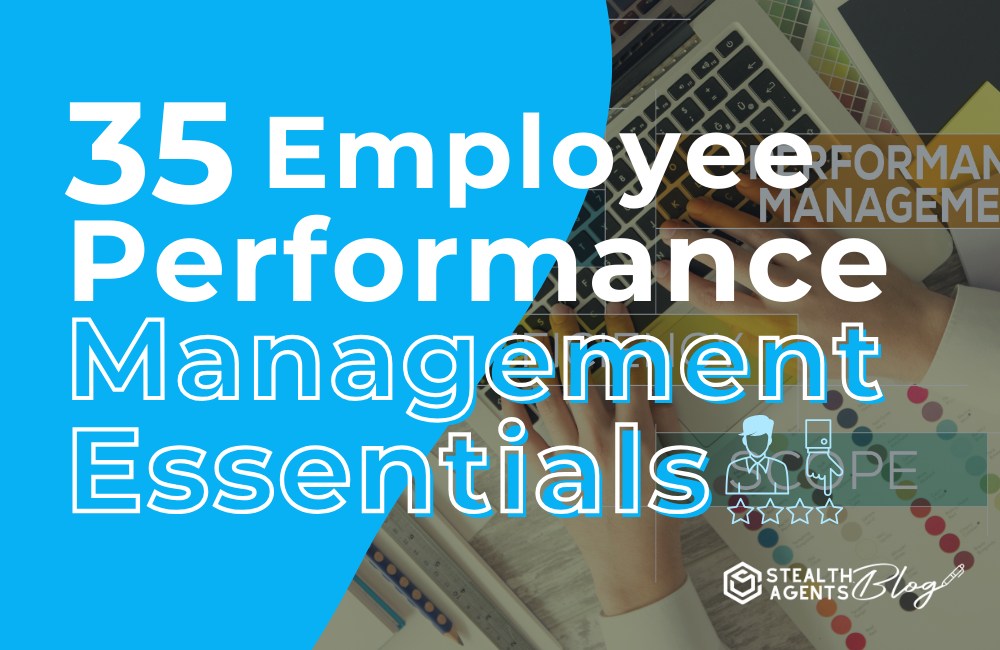35 Employee Performance Management Essentials
Welcome to our guide on the 35 key essentials of employee performance management! In this comprehensive resource, we will cover everything you need to know about effectively managing and maximizing your employees’ performance. From setting goals and providing feedback to measuring results and promoting growth, these essential practices will help you create a high-performing team that drives success for your business. Let’s dive in!
A Guide to Maximizing Your Team’s Potential
As a leader, one of your main responsibilities is to manage and optimize the performance of your employees. This can be a challenging task, but with the right tools and strategies, you can create a high-performing team that drives success for your business. In this guide, we will explore the 35 key essentials of employee performance management that will help you effectively lead and develop your team. Let’s get started!
-
Performance Appraisal: The process of evaluating employee performance against predefined criteria.
-
360-Degree Feedback: A method of performance review where an employee’s performance is assessed by their supervisor, peers, subordinates, and sometimes, clients.
-
Key Performance Indicators (KPIs): Quantifiable measures used to evaluate the success of an employee in meeting objectives for performance.
-
Goal Setting: The process of establishing objectives to guide employee performance.
-
Self-Assessment: Employees evaluating their own performance based on set criteria.
-
Performance Improvement Plan (PIP): A tool to give employees with performance deficiencies the opportunity to succeed.
-
Competency Framework: A structured system to define and measure employees’ skills, behaviors, and attributes.
-
Career Development Plan: A detailed plan including an employee’s professional goals and the actions they need to take to achieve them.
-
Succession Planning: Identifying and developing future leaders in the company, at all levels.
-
Employee Engagement: The emotional commitment the employee has to the organization and its goals.
-
Coaching and Mentoring: Guidance provided by a senior employee to help in the professional development of a junior employee.
-
Performance Metrics: Standards or measurements used to assess the effectiveness and efficiency of employee performance.
-
Behavioral Assessment: Evaluation of the behavior of employees and its impact on performance.
-
Balanced Scorecard: A strategy management tool used to monitor the performance of employees and organizations.
-
Training and Development: Programs to enhance the knowledge and skills of employees.
-
Feedback Culture: A work culture that encourages the giving and receiving of feedback among all members of the organization.
-
Annual Review: A yearly meeting between an employee and manager to discuss the employee’s performance.
-
Job Analysis: The process of determining and documenting the duties, responsibilities, and specifications of a job.
-
Employee Recognition: Acknowledging or rewarding the achievements and contributions of employees.
-
Performance Rating Scale: A tool used to assess employees’ performance on a scale, typically ranging from poor to excellent.
-
Continuous Performance Management: An ongoing process of communication and feedback between a supervisor and an employee.
-
Talent Management: The process of identifying, developing, and retaining talented employees.
-
Performance-Based Incentives: Financial rewards given to employees based on their work performance.
-
Peer Review: Performance assessment conducted by colleagues at the same level in the organization.
-
Management by Objectives (MBO): A management model aiming to improve the performance of an organization by clearly defining objectives.
-
Constructive Feedback: Providing actionable, specific feedback to help employees improve their performance.
-
Workforce Analytics: The use of data analysis and modeling to understand, improve, and optimize the workforce.
-
Employee Productivity: The measure of an employee’s efficiency in their job role.
-
Skill Gap Analysis: The process of identifying the skills that an employee needs to improve.
-
Employee Burnout: A state of physical, emotional, and mental exhaustion caused by excessive and prolonged stress in the workplace.
-
Performance Counselling: A process that provides employees with advice on how to improve work performance.
-
Job Satisfaction: The level of contentment employees feel about their work, which can affect their performance.
-
Organizational Development: A planned, systematic approach to improving the effectiveness of a company.
-
Employee Turnover: The rate at which employees leave a workforce and are replaced.
-
Performance Benchmarking: Comparing the performance of one’s company to that of other companies in the same industry.
Conclusion
In conclusion, having a strong employee performance management system in place is essential for any organization looking to succeed. From setting clear goals to providing feedback and recognition, these 35 essentials are crucial in effectively managing and developing your employees’ performance. By implementing these strategies, you can create a positive work culture and drive productivity and success within your company. So don’t wait, start implementing these essentials today and watch your employees thrive!











